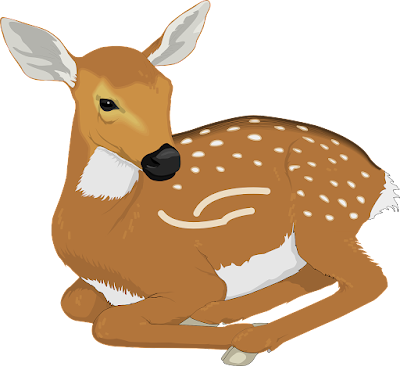The whitetail is named for its large fluffy whitetail, they wave or flag as they run from danger.

Read More: Squirrels: Characteristics, Facts, and Distribution
White-tailed deer is one of the most recognizable and valued wild animals in North America. Few animals capture the hearts minds and imaginations like the whitetail deer, as it was first called beautiful graceful, and cunning, and the source of lean delicious animal protein for millions of people each year.
Distribution
Whitetail is one of six members
of the deer family in North America. The others include mule deer, black-tailed
deer, elk moose, and caribou. It is the most common deer that lived in the Eastern
half of the United States.
White-tailed
deer, normally a cherished North
American game animal, have even become pests in
suburbs and cities in the United States and Canada.
The whitetail is the most numerous and widely
distributed big-game animal in the world ranging from central Canada down
through the United States, Mexico Central America, and even northern South
America.
There are nearly 30 million whitetails in the United States alone.
They can live in mountains
prairies, forests, deserts, and even jungles and they can also live in backyards,
this is due to their ability to adapt to humans.
Read More: DeathStalker Scorpion
Nutrition
The incredible number of foods
they can eat; hundreds of species of deer are primarily browsers. They
concentrate on weeds and shrubs, acorns, nuts, and berries more than grazers which
eat primarily grasses.
Body Colour
There is a stark contrast to their
brownish Gray winter coats which blend nicely into the fall landscape. This
coat is replaced during spring with a more reddish-colored version, it helps
them stay cooler during the warmer summer months.
A typical heard of whitetails
contains Bucks toes and fawns Bucks are males, one year of age or older those
are females, one year of age or older fawns are both males and females, under one
year of age pods can be further classified as buck fawns and doe fawns.
Life Span
The lifespan of a whitetail is
typically less than four years in the wild. Some have been known to survive
into their late teens and early 20s.
The oldest-known white-tailed is
24 years.
In captivity, a typical whitetail
family group is made up of related females, mothers, daughters, granddaughters, and their offspring.
Both males and females, under 1
and a half years of age, in time the young Bucks will be kicked out of the
family group and forced to move to new areas to live, this process is called
dispersal.
It is simply nature's way of
ensuring that males and females from the same family don't interbreed the area
in which the deer lives are known as its home range.
While it varies considerably the
bucks home ranges typically around 750 to a thousand acres whereas, it does is
roughly half of this.
Read More: Dragon lizard: Characteristics, habitat, and lifestyle
Social Behaviour
Unlike some species of deer that
form large herds containing both bucks and doze.
Whitetail bucks and doze leave
largely separate lives except during the breeding season.

During a late winter. Bucks often
form bachelor groups which are simply groups of Bucks of similar age or rank.
These groups stay together
throughout the spring and summer but break up before the breeding season or rut
which typically occurs in November.
The timing of the rut can be
highly variable in the Southern United States male whitetails grow antlers
whereas females do not.
During a buck fawn, the first year
of life it grows only small nubs or buttons that's why these youngsters are
often called nubbins or button bucks.
During a buck's second and
subsequent years of life, they grow larger antlers.
Each year at least through six
and a half or seven and a half years of age the weight of a buck can vary
considerably, based on where it lives, what it eats, and its age but they
average around 170 to 200 pounds.
Some have weighed in at more than
375 pounds.
Those weigh considerably less
with most playing around 80 to 100 pounds at maturity.
Whitetails are very good mothers;
the first time a doe gives birth is approximately 195 to 200 days after breeding.
They typically give birth to
twins every year, triplets are rare but do occur especially in areas with
exceptional habitat quality.
White tails have a unique bond
survival strategy, the first month of life instead of trying to keep up with
their mother bonds, hide by lying motionless for days. In end only gets up to
nurse or to be moved to a new hiding spot by its mother this lasts for nearly a
month before the font is large enough and strong enough to keep up with its
mother.
Read More: Texas coral snake: Identification, Characteristics, Facts, Behaviour, Poison, Antivenom
Communication
Fawns are very vulnerable during
this period and many are taken by predators such as coyotes and bears.
Whitetails don't have a complex
language like humans, they do communicate with each other.
They use more than a dozen calls
to communicate everything from danger to aggression to attraction.
The most common vocalization or
grunts and snorts and hunters often use calls that mimic these sounds. while
hunting Tilden also uses behavior and body language to communicate aggressive
behaviors like raising their heads high above another deer allowing their ears
back or walking sideways, stiff-legged are clear signals of aggression.
Aggressive Behaviour
If the warning is not hated more
aggressive behaviors are likely to follow including flailing or kickboxing
among those Bucks will often make all their hair stand up on its end making
themselves look darker and more menacing which may ultimately be followed by a
fight, involving the clashing of antlers and file it pushing and shoving until
one of the Bucks gives up.





No comments:
Please do not enter any spam message in the link.